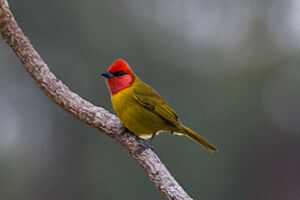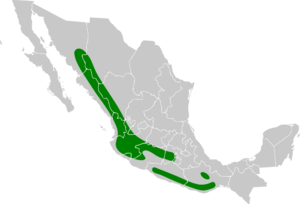Red-headed tanager facts for kids
Quick facts for kids Red-headed tanager |
|
|---|---|
 |
|
| Conservation status | |
| Scientific classification | |
| Genus: |
Piranga
|
| Species: |
erythrocephala
|
 |
|
The red-headed tanager (Piranga erythrocephala) is a colorful songbird found only in Mexico. It's a medium-sized bird, about 15 cm (6 inches) long. This bird belongs to the Cardinalidae family, which includes cardinals and grosbeaks. Male red-headed tanagers are mostly yellow-olive with a bright red head and throat. Females have a yellow front part of their head. There are two types, or subspecies, of this bird.
Contents
About the Red-headed Tanager
The red-headed tanager was first described in 1827 by an English scientist named William Swainson. He named it Spermagra erythrocephala. The information came from a bird collected in Temascaltepec, Mexico.
For a long time, this bird and others in its group, Piranga, were thought to be part of the "true" tanager family, Thraupidae. But around 2008, scientists learned more about them. They decided these birds actually belong to the Cardinalidae family. This is the same family as cardinals and grosbeaks.
Red-headed Tanager Subspecies
There are two recognized types, or subspecies, of the red-headed tanager:
- Piranga erythrocephala erythrocephala (the main type)
- Piranga erythrocephala candida
What Does a Red-headed Tanager Look Like?
The red-headed tanager is about 15 cm (6 inches) long. It weighs between 19.9 and 24.5 grams (0.7 to 0.9 ounces).
Male and Female Birds
Male birds of the main type (P. e. erythrocephala) have a bright red head, face, throat, and upper chest. The rest of their upper body is a bright yellow-olive color. Their lower body is olive-yellow. They also have a thin black mask around their eyes.
Female birds have a yellow front part of their head. The rest of their upper body is yellow-olive. Their throat and chest are yellow, fading to a lighter, buffy white color towards their tail. Young males look a lot like bright female birds.
The P. e. candida subspecies looks similar to the main type. However, it is usually a bit duller and darker in color.
Where Red-headed Tanagers Live
The red-headed tanager lives only in Mexico. The main subspecies (P. e. erythrocephala) is found in different areas. These areas stretch from the state of Jalisco south to eastern Oaxaca.
The P. e. candida subspecies lives further north. It can be found from southern Sonora and Chihuahua south to Jalisco. Sometimes, it is seen even further south when it's not breeding season.
Red-headed Tanager Habitat
These birds live in many kinds of wooded areas. They like semi-humid and moist montane forests. They also live in pine-oak forests, evergreen forests, and open woodlands with bushes. You can find them along the edges of forests and in tree plantations too. They usually live at elevations from 900 to 2600 meters (3,000 to 8,500 feet) above sea level.
Red-headed Tanager Behavior
What Red-headed Tanagers Eat
Red-headed tanagers usually look for food in pairs or small groups. They eat insects and small fruits, like berries. They prefer to search for food in the middle or upper parts of trees. They often stay hidden in the leaves. Sometimes, they will go to the ends of branches to find food.
Red-headed Tanager Reproduction
The nest of a red-headed tanager is shaped like a cup. It is made of fine twigs. They place their nests in trees, usually at a middle to upper height. Scientists do not have much more information about how these birds breed.
Red-headed Tanager Sounds
The song of the red-headed tanager is long and slow. It sounds like "chur chew che-wier chéé-chur wee chur cheer chéé-chur." Another call they make sounds like "tsi-tsi tsee-tsee." They also have several other calls.
Conservation Status
The IUCN (International Union for Conservation of Nature) has looked at the red-headed tanager. They have decided it is a species of "Least Concern." This means it is not currently in danger of disappearing.
The bird lives in several protected areas. Also, many parts of its home range outside these areas still have healthy habitats. It seems very likely that this bird will be safe for a long time.
Images for kids




